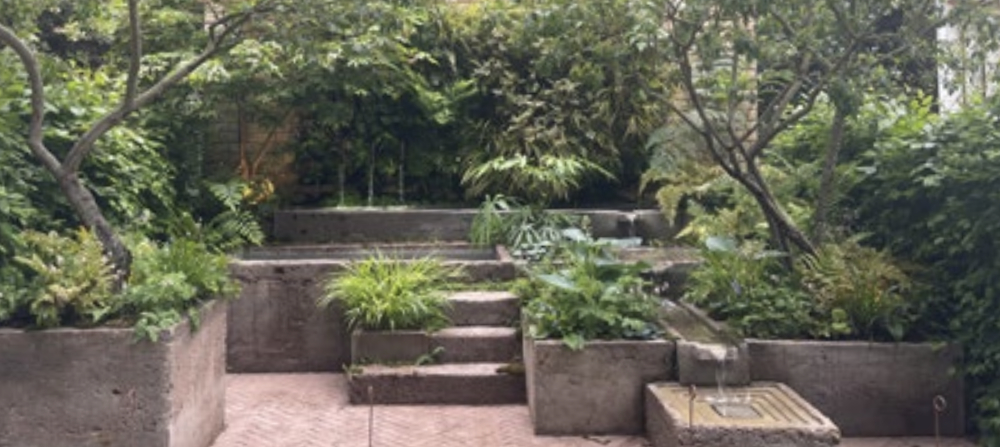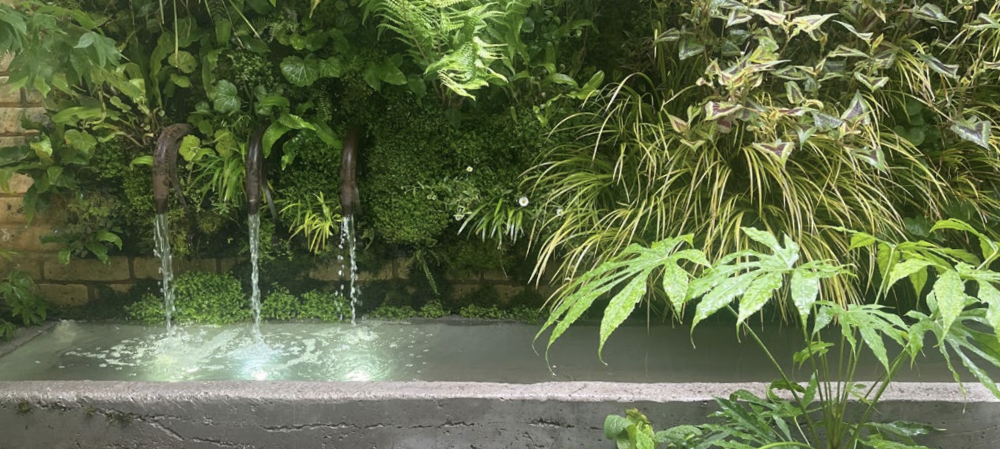Microcosm of biodiversity in balconies and containers: minor design adaptations for considerable biodiversity benefit
Perhaps as a direct response to the availability of new apartment blocks, one of the most popular recent additions to the RHS Chelsea Flower Show has been the Balcony and Container Gardens category.
Balcony designers create gardens measuring only 5m x 2m on a podium surrounded by railings,mimicking the balconies on apartment blocks; while container gardens are created at ground level to the same dimensions, representing a small back yard or front garden. Never has the phrase “small but perfectly formed” been truer than in the presentation of these gardens.
There is proven positive impact in terms of holistic health when people have access to green space. For homeowners and residents, this extends to their use of personal outdoor areas, no matter how small. For many people, the option of a large garden is simply not viable. Indeed, in some cases it is not desirable due to upkeep demands and nervousness about the skills required to care for a fully planted garden. But container gardening provides opportunities to create green oases in even the most unpromising situations, and those evidence-based holistic health benefits of interacting with nature, can be enjoyed with minimal horticultural knowledge or experience.
By extending the ethos of green infrastructure led developments, even the smallest outside space within a residential development can help address the challenge of climate change and biodiversity loss. There are previously untapped opportunities to enable owners or tenants of new apartments to make best use of their balconies. Providing drainage is an easy fix in a new build and can avoid the nuisance of irrigation water dripping onto lower levels. Ensuring the structures can bear the load of fully planted containers is essential and for that reason, built- in planters could be incorporated into the construction design and installation.
Where only small rear or front gardens are provided, rug-sized patches of lawn are often laid over poorly prepared ground. It takes no time at all for this turf to deteriorate, leaving new residents with low-grade outdoor spaces
that contribute nothing in terms of beauty, inspiration or ecological richness. Instead, we would recommend a permeable surface, with rustic bricks for a cottagey look, aggregate compacted into modules for a sunny area or resin aggregate for a sleek, contemporary finish, each providing a quality surface for pots and containers. An added bonus would be incorporating areas of drought-tolerant sedum lawns with permeable paths between. Again, built-in or installed planters around the boundaries would be a helpful contribution to new tenants or owners, and above-ground rain garden planters can support sustainable urban drainage systems (SuDS), slowing the pace of water run-off
from roofs.
In terms of ecology, developers are required to deliver a minimum 10% net gain in biodiversity (BNG) for new projects. Ground level planters in amenity areas planted with shrubs and climbers do score on the BNG matrix and Urban Greening Factor calculations (albeit with very low value), whilst those in private spaces will not contribute to the matrix calculation at all. There is nevertheless significant ecological benefit in well-planted private balconies and courtyards, providing food sources and habitats for birds and insects, and even small mammals and reptiles if suitable conditions prevail.
This also provides opportunity for developers to claim, with integrity, a best practice strategy for creating green spaces throughout the entirety of a project, providing another tool for those architectural proefessionals and developers who aspire to creating ecologically rich developments.
In terms of environmental responsibility, the property development sector faces huge challenges to achieve net zero emissions from construction projects. An essential factor in this is to move speedily toward green infrastructure-led developments where the networks of green spaces and habitats lead the design process, reversing the pattern of green interventions by simply filling the spaces left over from the building and road layouts.
Green infrastructure includes everything from macro interventions (woodlands, meadows, waterways) to micro ones (seed mixes, nectar rich perennial planting, climber clad walls). Balcony and container plants can be considered within the latter, even contributing to connectivity of green infrastructure when designed as integral elements of a development from the outset.
Few would disagree that any new development is at its best when it works in harmony with the natural environment, retaining a strong connection with nature and providing attractive open spaces that feature mature trees and hedgerows. Certainly, the big spaces provide more potential (and BNG reward), but the smaller pockets still have a role to play.
This presents another opportunity to bang the drum for greater collaboration between developers, architecture professionals, and landscape architects. We in the latter group have long been the last invitee at the table, arriving when the tasty courses have been devoured and left to pick at the last crumbs. Those days are – should – be behind
us, with green-infrastructure-led developments being recognised as some of the best forms of development for humankind and wildlife.
It is easy to switch to leading with green infrastructure by working with landscape architects from the
start and, given the opportunity, we will not only address the large open spaces within developments, but also explore every opportunity to create these precious pockets that so many homeowners – and wildlife – enjoy.
Who knows, perhaps one day we can aspire to the lofty heights of Tree House or Park Royal Hotel in Singapore in delivering vegetation-clad buildings that enhance urban street-scenes, increase biodiversity, reduce urban heat, and bring joy to residents and passers-by.
This article appears in the AT Journal issue 152 Winter 2024 as 'Microcosm of biodiversity in balconies and containers: minor design adaptations for considerable biodiversity benefit' written by Anne Jennings FLI MBALI MCIHort, Associate Director of Landscape Architecture, Lanpro Services.
--CIAT
[edit] Related articles on Designing Buildings
- Blue belt.
- Blue roof.
- Blue space.
- Green-Blue infrastructure.
- Green infrastructure.
- Green roof.
- Infrastructure.
- London's Blue Ribbon Network.
- Biodiversity in building design and construction
- Biodiversity in the urban environment.
- Biodiversity Gain.
- Biodiversity gain plan.
- Biodiversity gain site.
- Biodiversity gain site register.
- Biodiversity net gain consultation.
- Biodiversity net gain regulations and implementation.
- Biodiversity net gain.
- Biodiversity net gain with related updates and terms explained.
- Biodiversity offsetting.
- Biodiversity units.
- Biodiversity metric.
- Blue belt.
- Blue roof.
- Blue space.
- Ecological impact assessment.
- Ecology.
- Environmental impact assessment.
- Green-Blue infrastructure.
- Green infrastructure.
- Green roof.
- Habitat.
- Habitat management and monitoring plan HMMP.
- Local Nature Recovery Strategy LNRS.
- London's Blue Ribbon Network.
Featured articles and news
CIOB report; a blueprint for SDGs and the built environment
Pairing the Sustainable Development Goals with projects.
Latest Build UK Building Safety Regime explainer published
Key elements in one short, now updated document.
UKGBC launch the UK Climate Resilience Roadmap
First guidance of its kind on direct climate impacts for the built environment and how it can adapt.
CLC Health, Safety and Wellbeing Strategy 2025
Launched by the Minister for Industry to look at fatalities on site, improving mental health and other issues.
One of the most impressive Victorian architects. Book review.
Common Assessment Standard now with building safety
New CAS update now includes mandatory building safety questions.
RTPI leader to become new CIOB Chief Executive Officer
Dr Victoria Hills MRTPI, FICE to take over after Caroline Gumble’s departure.
Social and affordable housing, a long term plan for delivery
The “Delivering a Decade of Renewal for Social and Affordable Housing” strategy sets out future path.
A change to adoptive architecture
Effects of global weather warming on architectural detailing, material choice and human interaction.
The proposed publicly owned and backed subsidiary of Homes England, to facilitate new homes.
How big is the problem and what can we do to mitigate the effects?
Overheating guidance and tools for building designers
A number of cool guides to help with the heat.
The UK's Modern Industrial Strategy: A 10 year plan
Previous consultation criticism, current key elements and general support with some persisting reservations.
Building Safety Regulator reforms
New roles, new staff and a new fast track service pave the way for a single construction regulator.
Architectural Technologist CPDs and Communications
CIAT CPD… and how you can do it!
Cooling centres and cool spaces
Managing extreme heat in cities by directing the public to places for heat stress relief and water sources.
Winter gardens: A brief history and warm variations
Extending the season with glass in different forms and terms.
Restoring Great Yarmouth's Winter Gardens
Transforming one of the least sustainable constructions imaginable.



























